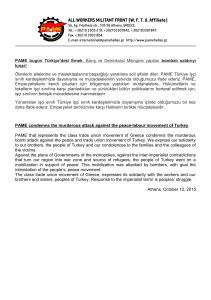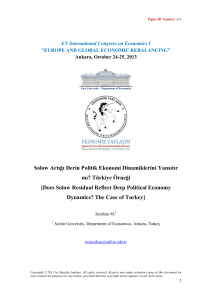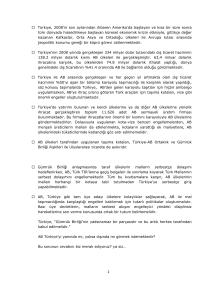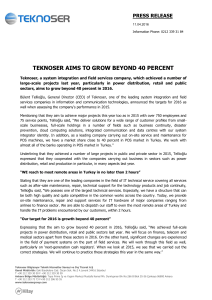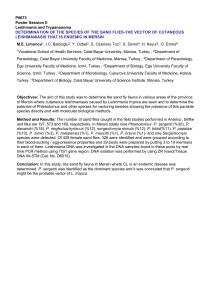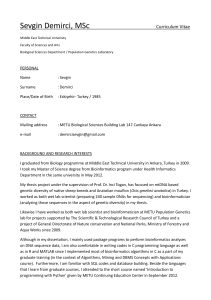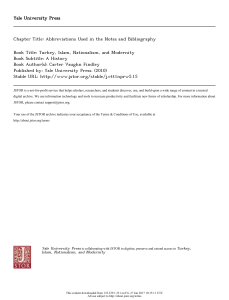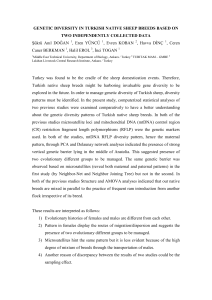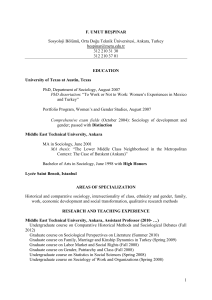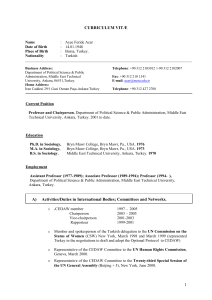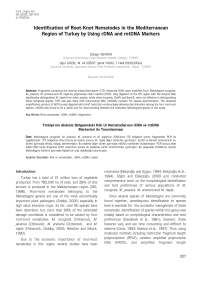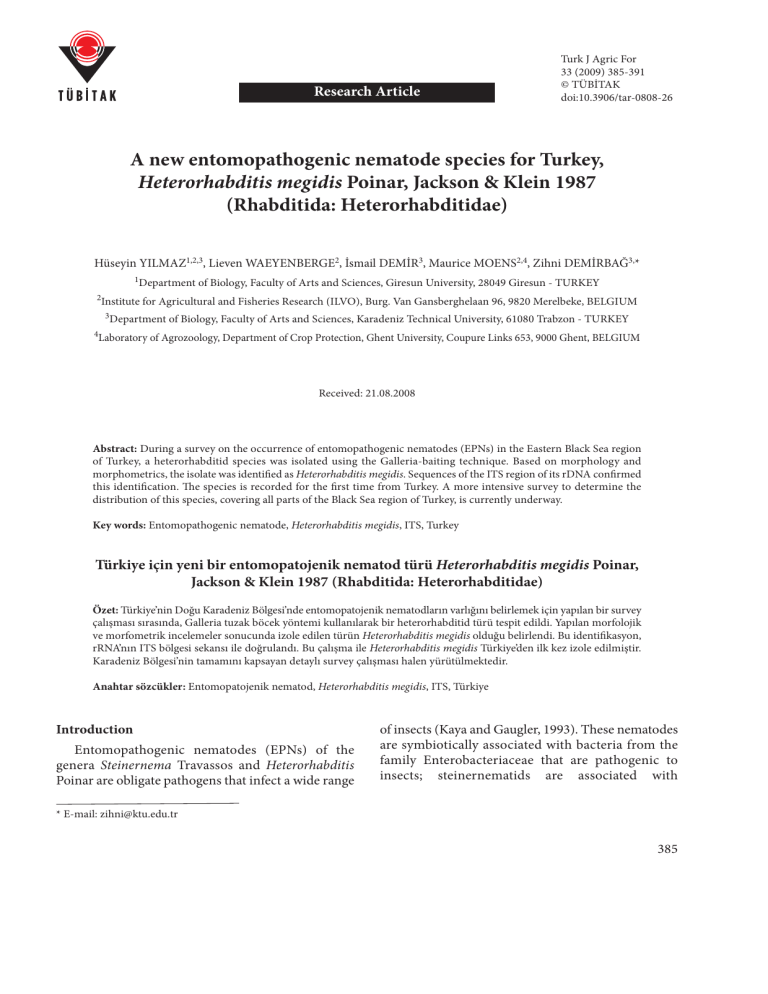
Research Article
Turk J Agric For
33 (2009) 385-391
© TÜBİTAK
doi:10.3906/tar-0808-26
A new entomopathogenic nematode species for Turkey,
Heterorhabditis megidis Poinar, Jackson & Klein 1987
(Rhabditida: Heterorhabditidae)
Hüseyin YILMAZ1,2,3, Lieven WAEYENBERGE2, İsmail DEMİR3, Maurice MOENS2,4, Zihni DEMİRBAĞ3,*
1Department of Biology, Faculty of Arts and Sciences, Giresun University, 28049 Giresun - TURKEY
2Institute for Agricultural and Fisheries Research (ILVO), Burg. Van Gansberghelaan 96, 9820 Merelbeke, BELGIUM
3Department of Biology, Faculty of Arts and Sciences, Karadeniz Technical University, 61080 Trabzon - TURKEY
4Laboratory of Agrozoology, Department of Crop Protection, Ghent University, Coupure Links 653, 9000 Ghent, BELGIUM
Received: 21.08.2008
Abstract: During a survey on the occurrence of entomopathogenic nematodes (EPNs) in the Eastern Black Sea region
of Turkey, a heterorhabditid species was isolated using the Galleria-baiting technique. Based on morphology and
morphometrics, the isolate was identified as Heterorhabditis megidis. Sequences of the ITS region of its rDNA confirmed
this identification. The species is recorded for the first time from Turkey. A more intensive survey to determine the
distribution of this species, covering all parts of the Black Sea region of Turkey, is currently underway.
Key words: Entomopathogenic nematode, Heterorhabditis megidis, ITS, Turkey
Türkiye için yeni bir entomopatojenik nematod türü Heterorhabditis megidis Poinar,
Jackson & Klein 1987 (Rhabditida: Heterorhabditidae)
Özet: Türkiye’nin Doğu Karadeniz Bölgesi’nde entomopatojenik nematodların varlığını belirlemek için yapılan bir survey
çalışması sırasında, Galleria tuzak böcek yöntemi kullanılarak bir heterorhabditid türü tespit edildi. Yapılan morfolojik
ve morfometrik incelemeler sonucunda izole edilen türün Heterorhabditis megidis olduğu belirlendi. Bu identifikasyon,
rRNA’nın ITS bölgesi sekansı ile doğrulandı. Bu çalışma ile Heterorhabditis megidis Türkiye’den ilk kez izole edilmiştir.
Karadeniz Bölgesi’nin tamamını kapsayan detaylı survey çalışması halen yürütülmektedir.
Anahtar sözcükler: Entomopatojenik nematod, Heterorhabditis megidis, ITS, Türkiye
Introduction
Entomopathogenic nematodes (EPNs) of the
genera Steinernema Travassos and Heterorhabditis
Poinar are obligate pathogens that infect a wide range
of insects (Kaya and Gaugler, 1993). These nematodes
are symbiotically associated with bacteria from the
family Enterobacteriaceae that are pathogenic to
insects; steinernematids are associated with
* E-mail: [email protected]
385
A new entomopathogenic nematode species for Turkey, Heterorhabditis megidis
Poinar, Jackson & Klein 1987 (Rhabditida: Heterorhabditidae)
Xenorhabdus spp. and heterorhabditids with
Photorhabdus spp. (Boemare, 2002). The third-stage
infective juvenile (IJ) is the only free-living stage that
persists in the soil in search of a susceptible arthropod
host. Following entry through the cuticle and/or
natural openings (i.e. the mouth, anus, and spiracles),
IJs release the symbiotic bacteria into the insect
hemocoel, multiply, and kill the host, usually within
24-48 h (Ciche and Ensign, 2003). Nematodes feed on
the symbiotic bacteria and complete 1-3 generations
in the host cadaver. When food resources become
depleted, new IJs either remain at the site where they
were produced or disperse in search of new hosts.
When screening EPN species or strains for
controlling a specific insect pest, the better adapted
an EPN is to local environmental conditions and the
targeted pest, the higher the level of efficacy likely to
be achieved (Bedding, 1990). Therefore, it is
important to survey and preserve indigenous EPN
species or strains. Different nematode species and
strains exhibit differences in survival, search behavior,
and infectivity, which make them more or less suitable
for particular insect pest control programs (Del Pino
and Palomo, 1996). As such, there is great interest in
finding wild populations to obtain new species and
strains for possible use in biological control. At the
time of the writing this paper, there were about 76
valid EPN species that belong to the Steinernematidae
(60) or Heterorhabditidae (16).
Turkey, a country of 814,578 km2, is located
between Europe and Asia. The country has diverse
climates, suggesting the possibility of large EPN
diversity. A few EPN surveys reported the presence of
S. affine, S. carpocapsae, S. feltiae, S. weiseri, S.
anatoliense, H. bacteriophora, and H. marelata (Özer
et al., 1995; Kepenekçi et al., 1999; Kepenekçi and
Susurluk, 2000, 2003; Susurluk et al., 2001, 2003;
Kepenekçi, 2002; Hazır et al., 2003a, 2003b; Ünlü et
al., 2007). Herein we report the occurrence of H.
megidis in Turkey for the first time.
Materials and methods
Origin, nematode isolation, and morphological
observation
An entomopathogenic nematode isolate named
P69 was obtained in July 2006 from a soil sample
386
collected from the bank of a brook close to a tea
plantation in Pazar (41°07ʹN, 40°45ʹE; 5 m asl; city of
Rize, Eastern Black Sea region of Turkey). The soil
sample, a composite of 5 random sub-samples (in
total ca. 1 kg), was taken from an area of 100 m2 and
from a depth of 20 cm. Soil type was light yellow
sandy loam. A subsample of 200 g was baited with 10
last instar Galleria mellonella (L.) larvae (Bedding and
Akhurst, 1975). One week later, dead larvae were
placed onto White traps (White, 1927) and emerging
IJs were collected and stored at 15 °C in aerated water
(Kaya and Stock, 1997). To confirm their
pathogenicity to insects, the IJs were transferred onto
moist filter paper in petri dishes to which living G.
mellonella larvae were added.
First and second generation adult nematodes were
obtained by dissecting infected last instar G.
mellonella larvae 5-6 and 8-9 days after infection,
respectively. For the identification of EPN, 20
specimens from each developmental stage (first
generation hermaphroditic female, male, and IJ) were
randomly selected from different G. mellonella
cadavers. Nematodes were killed and fixed in hot 4%
formalin (50-60 °C) and kept in this solution for 48 h.
Fixed nematodes were transferred to anhydrous
glycerin, according to Seinhorst’s (1959) rapid method
as modified by De Grisse (1969), and mounted on
slides using cover-glass supports to avoid flattening.
All measurements were made using a drawing tube
attached to an Olympus BX50 light microscope. The
nematodes were identified according to a selection of
morphological and morphometrical criteria (Stock
and Kaya, 1996).
DNA extraction, PCR, and DNA purification
and sequencing
DNA was extracted from a single hermaphroditic
female using a modification of the method of Joyce et
al. (1994). The specimen was cut in 8 μL of double
distilled H2O. The nematode fragments were
transferred into an Eppendorf tube to which 8 μL of
worm lysis buffer (500 mM of KCl, 100 mM of TrisCl [pH 8.3], 15 mM of MgCl2, 10 mM of DTT, 4.5%
Tween 20, and 0.1% gelatin) and 2 μL of proteinase K
−1
(600 μg mL ) were added. After freezing (−70 °C for
10 min) the tubes were incubated at 65 °C for 1 h and
then at 95 °C for 10 min.
H. YILMAZ, L. WAEYENBERGE, İ. DEMİR, M. MOENS, Z. DEMİRBAĞ
After centrifugation (13,000 ×g for 1 min) of the
tubes, 5 μL of the DNA suspension was added to a PCR
reaction mixture that contained 5 μL of 10× PCR buffer,
2 μL of MgCl2 (25 mM), 1 μL of dNTP mixture (10 mM
each), 0.3 μL (500 nM) of each primer, 1.5 U of Taq DNA
polymerase, and 36 μL of double distilled water, to a final
volume of 50 μL. The forward primer TW81 (5’GTTTCCGTAGGTGAACCTGC-3’) and the reverse
primer AB28 (5’-ATATGCTTAAGTTCAGCGGGT-3’)
were used in the PCR reaction for amplification of the
complete ITS region (Joyce et al., 1994). The
amplification profile was carried out using a PTC-100
thermocycler, which was preheated to 95 °C for 2 min,
followed by 35 cycles of 94 °C for 30 s, 50 °C for 30 s,
and 72 °C for 1 min, and then 72 °C for 8 min. After
DNA amplification, 5 μL of the product was loaded
on 1% agarose gel for DNA checking. Amplified
products were purified using a Qiagen Gel
Purification Kit (Qiagen Ltd, Leusden, The
Netherlands).
The purified PCR product was cloned using
pGEM-T vector and JM109 High Efficiency
Competent Cells (Promega, Leiden, The
Netherlands), according to the manufacturer’s
instructions. PCR products from selected clones were
sequenced with the BigDye Terminator Cycle
Sequencing Ready Reaction Kit (Applied Biosystems
AH Nieuwerkerk a/d Ijissel, The Netherlands). The
resulting products were purified using a Centriflex
Gel Filtration Cartridge (Edge BioSystems Inc.,
Gaithersburg, MD, USA). The DNA sequence was
edited with Chromas v.1.45 and aligned using Clustal
W (Thomson et al., 1994) with sequences of related
species and isolates available in GenBank.
Results
The nematode population that was isolated from
the sample taken at Pazar showed the typical
developmental pattern of heterorhabditids in insect
hosts.
Morphological
and
morphometric
investigations of the isolate were performed, and the
data are given in Table 1 and Figure 1.
A BLAST search indicated 99% similarity between
the H. megidis P69 sequence and that of the 2 H.
megidis isolates previously submitted to GenBank
(accession numbers EF043439 and AY321480), and
97% similarity with another H. megidis isolate
(accession number AY293284). Other comparable
sequences were those from H. downesi (AY321482),
with 93% similarity, and H. marelatus (EF043441),
with 91% similarity. The alignment of the sequences
of the above-mentioned isolates is presented in Figure
2. The sequences of all other Heterorhabditis species
available in GenBank showed less than 90% similarity.
Discussion
Taxonomic investigations showed that the
population was conspecific with H. megidis. With
respect to morphometrics, the main difference
between the infective stages of H. megidis and the
other species of the genus is body length. Mean length
of H. megidis IJs, mean distance from the head to the
secretory/excretory pore, and mean length of the
pharynx separate this species from other described
Heterorhabditis species. For the males, the ratio of the
length of the gubernaculum to the length of the
spicule distinguishes H. megidis (< 0.5 μm) from other
species (Adams and Nguyen, 2002). The
morphometrics of both the hermaphroditic female
and the male of H. megidis P69 (Table 1) fit those of
the original description of the species (Poinar et al.,
1987). Characteristic data of the IJ are slightly lower
than those of the original description.
Heterorhabditis megidis was originally isolated
from the Japanese beetle, Popillia japonica
(Coleoptera, Scarabaeidae), in Ohio (Poinar et al.,
1987). The nematode is widespread in the temperate
regions of Europe (Hominick, 2002). It was also
isolated in Greece (Menti et al., 1997), Israel (Glazer
et al., 1993), Japan (Yoshida et al., 1998), Russia
(Fischer-Le Saux et al., 1998), and Canada (Mracek
and Webster, 1993). This is the first record of the
natural occurrence of H. megidis in Turkey. We
isolated the nematode from sandy loam soil in Pazar,
at a very low altitude. Heterorhabditids are frequently
found at sites adjacent to the sea (Hara et al., 1991;
Waturu, 1998; Yoshida et al., 1998; Griffin et al., 1999;
Griffin et al., 2000; Rosa et al., 2000). Their
387
A new entomopathogenic nematode species for Turkey, Heterorhabditis megidis
Poinar, Jackson & Klein 1987 (Rhabditida: Heterorhabditidae)
Table 1. Morphometrics (in μm) of Heterorhabditis megidis P69. Data are expressed as mean ± SD (range).
H. megidis
P69
H. megidis
(after Poinar et al., 1987)
Characters
Hermaphroditic
female
Male
Infective
juvenile
Hermaphroditic
female
Male
Infective
juvenile
20
730.0 ± 29.4
(665.3-752.2)
111.7 ± 4.9
(102.8-117.9)
95.9 ± 2.6
(93.4-99.6)
138.6 ± 4.5
(130.9-145.5)
93.0 ± 7.0
(80.3-103.8)
13.7 ± 1.9
(11.2-16.8)
26.2 ± 1.3
(23.8-27.9)
NA
15
3600
(2400-4900)
209
(193-270)
162
(139-178)
229
(206-269)
105
(95-124)
63
(38-86)
209
(120-333)
NA
SW
NA
NA
NA
GL
NA
NA
NA
GW
NA
NA
NA
TR
NA
NA
NA
V%
46.0 ± 2.5
(43.5-48.9)
18.0 ± 3.5
(13.9-21.9)
15.6 ± 1.5
(14.0-17.5)
35.9 ± 5.9
(30.6-42.7)
90.4 ± 1.4
(88.9-92.2)
206.7 ± 14.5
(189.0-221.4)
2.0 ± 0.2
(1.8-2.2)
20
1009.7 ± 59.7
(769.0-1071.7)
173.2 ± 14.6
(144.2-192.6)
114.6 ± 10.1
(99.7-131.9)
135.9 ± 4.3
(130.1-142.2)
41.5 ± 5.2
(34.6-47.9)
30.3 ± 4.0
(23.1-36.3)
51.1 ± 2.3
(47.3-54.8)
54.1 ± 2.8
(48.5-58.0)
6.8 ± 1.5
(4.3-8.2)
22.3 ± 1.8
(19.9-26.3)
1.4 ± 0.6
(0.4-2.1)
197.8 ± 53.5
(112.0-295.7)
NA
NA
20.9 ± 1.4
(17.2-22.4)
7.9 ± 0.5
(6.5-8.3)
26.8 ± 1.9
(23.3-29.1)
126.4 ± 10.0
(109.3-142.7)
426.2 ± 30.5
(389.0-480.3)
1.3 ± 0.1
(1.2-1.4)
27.9 ± 1.9
(25.5-31.2)
5.3 ± 0.1
(5.1-5.4)
7.9 ± 0.4
(7.0-8.3)
80.6 ± 2.9
(76.1-84.2)
120.5 ± 6.7
(110.8-128.9)
0.3 ± 0.0
(0.3-0.3)
48
(45-50)
17
(14-24)
15
(12-21)
34
(23-49)
91.3
15
1000
(800-1100)
156
(139-176)
104
(96-112)
128
(122-134)
39
(35-43)
26
(22-31)
47
(44-50)
49
(46-54)
6
(5-8)
21
(17-24)
1.1
(0.3-1.6)
138
(117-230)
NA
15
768
(736-800)
131
(123-142)
109
(104-115)
155
(147-160)
119
(112-128)
NA
SL
20
3889.2 ± 606.0
(3058.2-4447.9)
224.7 ± 27.3
(196.2-259.8)
180.3 ± 25.0
(149.2-207.3)
248.4 ± 26.5
(218.7-281.7)
109.5 ± 18.9
(97.6-137.4)
66.5 ± 14.7
(48.8-84.0)
219.3 ± 32.7
(175.9-255.0)
NA
19
(18-22)
8
(7-9)
26
(23-31)
122
26.5
(23-28)
5
(4.6-5.9)
6.5
(6.1-6.9)
84.5
(81-91)
110.1
(103-120)
0.2
n
L
EP
NR
ES
T
ABW
W
a
b
c
D%
E%
f
199
400
2
1.2
29
(27-32)
NA
NA
NA
NA
NA
NA
NA: Not available; n: number of species; L: total body length EP: distance from the anterior end to the excretory pore; NR: distance from
the anterior end to the nerve ring; ES: distance from the anterior end base of the basal bulb; T: tail length; ABW: anal body width;
W: maximum body width; SL: spicule length; SW: spicule width; GL: gubernaculum length; GW: gubernaculum length; TR: testis
reflection; V%: distance from the anterior end to vulva/total body length × 100; a: L/W; b: L/ES; c: L/T; D%: (EP/ES) × 100; E%:
(EP/T) × 100; f: W/T
388
H. YILMAZ, L. WAEYENBERGE, İ. DEMİR, M. MOENS, Z. DEMİRBAĞ
20 µm
100 µm
20 µm
100 µm
20 µm
20 µm
Figure 1. Light microphotographs of Heterorhabditis megidis P69. A: Spicule and gubernaculum. B: Bursa of a male. C: Eggs inside a
female. D: Vulva of a hermaphroditic female. E: Head of an infective juvenile. F: Annulations of an infective juvenile.
Figure 2. Multiple sequence alignment of the ITS region of Heterorhabditis species.
389
A new entomopathogenic nematode species for Turkey, Heterorhabditis megidis
Poinar, Jackson & Klein 1987 (Rhabditida: Heterorhabditidae)
association with sandy soils remains the most robust
correlation between habitat and the presence of
heterorhabditids (Hominick, 2002). Heterorhabditis
megidis is also widely distributed in turf and weedy
habitats (Stuart and Gaugler, 1994; Stock et al., 1996).
We only found one population of this species, but
a more intensive survey, covering all parts of the Black
Sea region of Turkey, is currently underway and may
yield more populations, adding important data
concerning the distribution of this nematode in
Turkish soils. Further research will address the
associated bacteria and insecticidal activity against
economically important insect pests in this region.
Acknowledgements
We thank Ali Sevim (Rize University) for his help
in collecting the samples, and Zeliha Çolak Yılmaz
(Giresun University) and Dr. Sergei Spiridonov
(Russian Academy of Science) for their laboratory
assistance regarding molecular analysis and
morphometrics. We also thank Dr. Selçuk Hazır
(Adnan Menderes University) for his valuable
comments on the manuscript. This study was
supported by the Karadeniz Technical University
Research Foundation (KTU 2006.111.004.3) and a
grant from The Scientific and Technological Research
Council of Turkey (TÜBİTAK).
References
Adams, B.J. and K.B. Nguyen. 2002. Taxonomy and Systematics. In:
Entomopathogenic Nematology, (Ed.: R. Gaugler). CABI
Publishing, Wallingford UK, pp 1-33.
Bedding, R.A. and R.J. Akhurst. 1975. A simple technique for
detection of insect parasitic rhabditid nematodes in soil.
Nematologica. 21: 109-110.
Bedding, R.A. 1990. Logistics and strategies for introducing
entomopathogenic nematodes technology into developing
countries. In: Entomopathogenic Nematodes in Biological
Control, (Eds.: R. Gaugler and H.K. Kaya). CRC press, Florida,
pp 233-245.
Boemare, N. 2002. Biology, Taxonomy and Systematics of
Photorhabdus and Xenorhabdus. In: Entomopathogenic
Nematology, (Ed.: R. Gaugler). CABI Publishing, Wallingford
UK, pp 35-56.
Ciche, T.A and J.C. Ensign. 2003. For the insect pathogen,
Photorhabdus luminescens, which end of a nematode is out?
Appl. Environ. Microbiol. 69: 1890-1897.
De Grisse, A.T. 1969. Redescription ou modifications de quelques
techniques utilisées dans l’étude de nématodes
phytoparasitaires.
Mededelingen
Rijksfaculteit
Landbouwwetenschappen Gent. 34: 315-359.
Del Pino, G.F. and A. Palomo. 1996. Natural occurrence of
entomopathogenic nematodes (Rhabditida: Steinernematidae
and Heterorhabditidae) in Spanish soils. J. Invertebr. Pathol. 68:
84-90.
Fischer-Le Saux, M., H. Mauleon, P. Constant, B. Brunel and N.
Boemare. 1998. PCR-ribotyping of Xenorhabdus and
Photorhabdus isolates from the Caribbean region in relation to
the taxonomy and geographic distribution of their nematode
hosts. Appl. Environ. Microbiol. 64: 4246-4254.
Glazer, I., N. Liran, G.O. Poinar and P.H. Smits. 1993. Identification
and biological activity of newly isolated heterorhabditid
populations from Israel. Fun. Appl. Nematol. 16: 467-472.
390
Griffin, C.T., I. Dix, S.A. Joyce, A.M. Burnell and M.J. Downes. 1999.
Isolation and characterization of Heterorhabditis ssp.
(Nematoda: Heterorhabditidae) from Hungary, Estonia and
Denmark. Nematology. 1: 321-332.
Griffin, C.T., R. Chaerani, D. Fallon, A.P. Reid and M.J. Downes. 2000.
Occurrence and distribution of the entomopathogenic
nematodes Steinernema ssp. and Heterorhabditis indica in
Indonesia. J. Helmintol. 74: 143-150.
Hara, A.H., R. Gaugler, H.K. Kaya and L.M. Lebeck. 1991. Natural
population of entomopathogenic nematodes (Rhabditida:
Heterorhabditidae, Steinernematidae) from the Hawaiian
islands. Environ. Entomol. 20: 211-216.
Hazır, S., S.P. Stock and N. Keskin. 2003a. A new entomopathogenic
nematode, Steinernema anatoliense n. sp. (Rhabditida:
Steinernematidae), from Turkey. Syst. Parasitol. 55: 211-220.
Hazır, S., N. Keskin, P.S. Stock, H.K. Kaya and S. Özcan. 2003b.
Diversity and distribution of entomopathogenic nematodes
(Rhabditida: Steinernematidae and Heterorhabditidae) in
Turkey. Biodivers. Conserv. 12: 375-386.
Hominick, W.M. 2002. Biogeography. In: Entomopathogenic
Nematology, (Ed.: R Gaugler), CABI Publishing, Wallingford,
UK, pp. 115-143.
Joyce, S.A., A. Reid, F. Driver and J. Curran. 1994. Application of
polymerase chain reaction (PCR) methods to identification of
entomopathogenic nematodes. In: Biotechnology: Genetics of
Entomopathogenic Nematode Bacteria Complexes, (Eds.: A.M.
Burnell, R.U. Ehlers, J.P. Masson), European Commission,
Luxembourg, DG XII, pp 178-187.
Kaya, H.K and R. Gaugler. 1993. Entomopathogenic nematodes. Ann.
Rev. Entomol. 38: 181-206.
Kaya, H.K. and S.P. Stock. 1997. Techniques in Insect Nematology. In:
Manual of Techniques in Insect Pathology, (Ed.: L.A. Lacey),
Academic Press, London, pp 281-324.
H. YILMAZ, L. WAEYENBERGE, İ. DEMİR, M. MOENS, Z. DEMİRBAĞ
Kepenekçi, İ., N.E. Babaroğlu, G. Öztürk and S. Halıcı. 1999. Türkiye
için yeni bir entomopatojen nematod; Heterorhabditis
bacteriophora Poinar, 1976 (Rhabditida: Heterorhabditidae).
Türkiye Entomoloji Derneği Yayınları. 9: 587-596.
Stock, P.S. and H.K. Kaya. 1996. A multivariate analysis of
morphometric characters of Heterorhabditis species (Nematoda:
Heterorhabditidae) and the role of morphometrics in the
taxonomy of species of genus. J. Parasitol. 82: 806-813.
Kepenekçi, İ. and İ.A. Susurluk. 2000. Türkiye için yeni bir
entomopatojen nematod türü; Heterorhabditis marelatus Lui
and Berry, 1996 (Rhabditida: Heterorhabditidae). Tarım
Bilimleri Dergisi. 6: 59-64.
Stock, P.S., D.R. Strong and S.L. Gardner. 1996. Identification of
Heterorhabditis (Nematoda: Heterorhabditidae) from California
with a new species isolated from the larvae of the ghost moth
Hepialis californicus (Lepidoptera: Hepialidae) from the Bodega
Bay Natural Reserve. Fun. Appl. Nematol. 19: 585-592.
Kepenekçi, İ. and İ.A. Susurluk. 2003. Three entomopathogenic
nematodes (Rhabditida) from Turkey. Pakistan J. Nematol. 21:
19-23.
Kepenekçi, I. 2002. Entomopathogenic nematodes (Rhabditida) in
the Mediterranean region of Turkey. Nematol. Mediter. 30: 1315.
Menti, H., D.J. Wright and R.N. Perry. 1997. Desiccation survival of
populations of the entomopathogenic nematodes Steinernema
feltiae and Heterorhabditis megidis from Greece and the UK. J.
Helmintol. 71: 41-46.
Mracek, Z. and J.M. Webster. 1993. Survey of Heterorhabditidae and
Steinernematidae (Rhabditida: Nematoda) in Western Canada.
J. Nematol. 25: 710-717.
Özer, N., N. Keskin and Z. Kırbaş. 1995. Occurrence of
entomopathogenic nematodes (Steinernematidae and
Heterorhabditidae) in Turkey. Nematologica. 41: 639-640.
Poinar, G.O., T. Jackson and M. Klein. 1987. Heterorhabditis megidis
sp. n. (Rhabditida: Heterorhabditidae) parasitic in the Japanese
betle, Popillia japonica (Scarabaeidae: Coleoptera), in Ohio.
Proceedings of the Helminthological Society of Washington. 54:
53-59.
Rosa, J.S., E. Bonifassi, J. Amaral, L.A. Lacey, N. Simoes and C.
Laumond. 2000. Natural occurrence of entomopathogenic
nematodes (Rhabditida: Steinernema, Heterorhabditis) in the
Azores. J. Nematol. 32: 215-222.
Seinhorst, J.W. 1959. A rapid method for the transfer of nematodes
from fixative to anhydrous glycerin. Nematologica 4: 67-69.
Stuart, R.J. and R. Gaugler. 1994. Patchiness in populations of
entomopathogenic nematodes. J. Invertebr. Pathol. 64: 39-45.
Susurluk, A., I. Dix, E. Stackebrandt, O. Strauch, U. Wyss and R.U.
Ehlers. 2001. Identification and ecological characterization of
three entomopathogenic nematode-bacterium complexes from
Turkey. Nematology. 3: 833-841.
Susurluk, A., S. Hollmer, U.K. Mehta, R. Han, E. Tarasco, O. Triggiani,
A. Peters, R.U. Ehlers. 2003. Molecular identification of
entomopathogenic nematodes from Turkey, India, China, Italy,
Norway, Albania and Germany by PCR-RFLP. In: 9th European
Meeting of the IOBC/WPRS Working Group, Schloss Salzau,
Germany.
Thompson, J.D., D.G. Higgins and T.J. Gibson. 1994. Clustal W:
improving the sensitivity of progressive multiple sequence
alignment though sequence weighting, position gap penalties
and weight matrix choice. Nucleic Acids Res. 22: 4673-4680.
Ünlü, I.O., R.U. Ehlers and A. Susurluk. 2007. Additional data and
first record of entomopathogenic nematode Steinernema weiseri
from Turkey. Nematology. 9: 739-741.
Waturu, C.N. 1998. Entomopathogenic nematodes (Steinernematidae
and Heterorhabditidae) from Kenya. PhD thesis, University of
Reading, UK, p. 191.
White, G.F. 1927. A method for obtaining infecting nematode larvae
from culture. Science. 66: 302-303.
Yoshida, M., A.P. Reid, B.R. Briscoe and W.M. Hominick. 1998.
Survey of entomopathogenic nematodes (Rhabditida:
Steinernematidae and Heterorhabditidae) in Japan. Fun. Appl.
Nematol. 21: 185-198.
391

